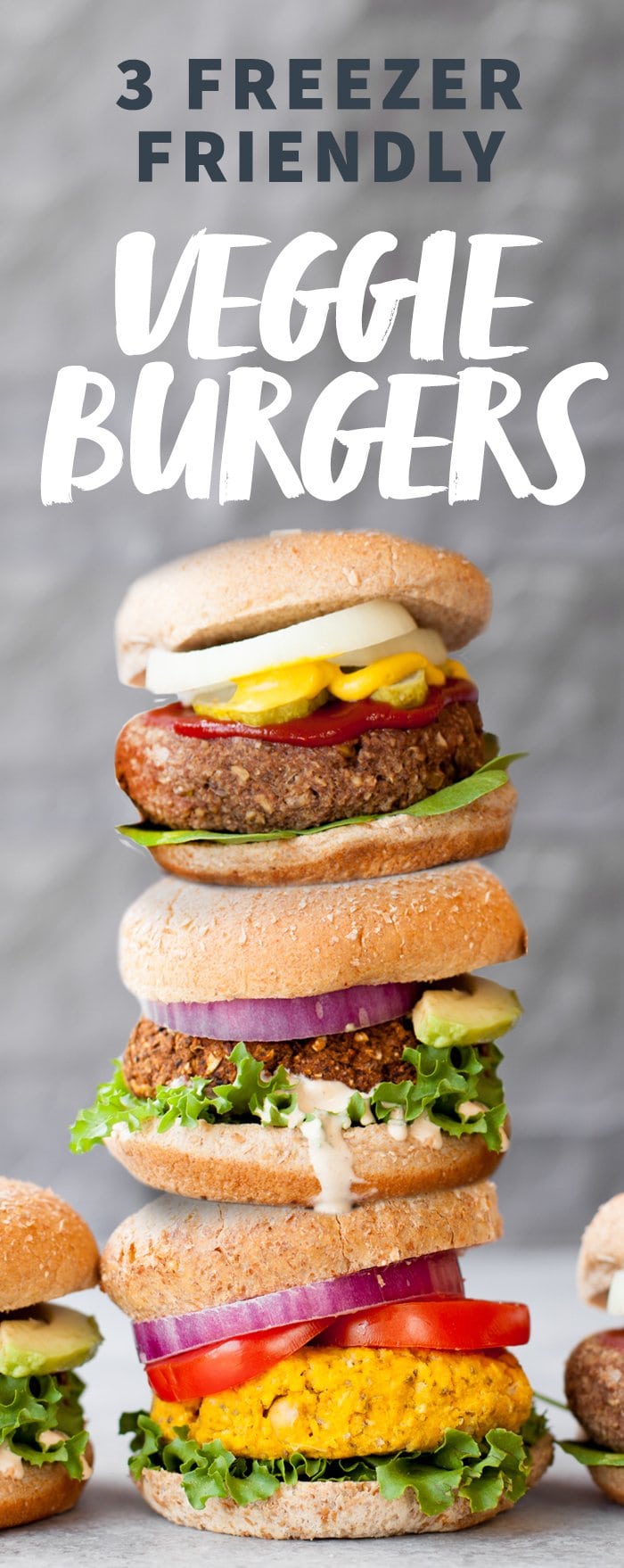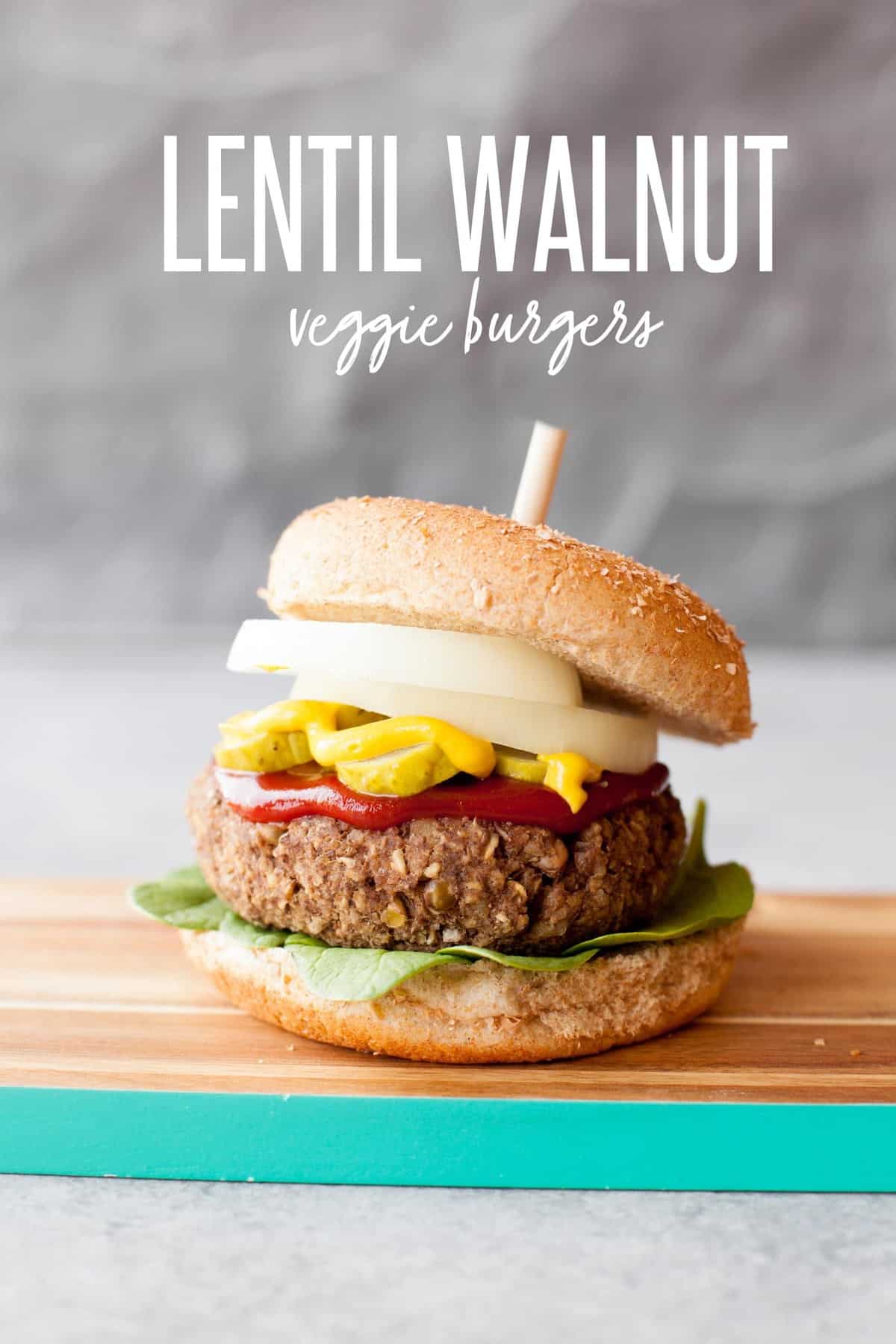If you were to show up at my house right now, open my freezer, and take a peek inside you’d see lots of bread (we can never get through a loaf before it starts to go bad—so we always keep our bread in the freezer); a few bags of frozen berries, beans, and veggies; and lots and lots of veggie burgers.
Veggie burgers are a “pantry staple” in our house. When the cupboards are bare and I have no idea what to make for supper, I can always fall back on the veggie burgers in the freezer.
Veggie burgers are one of those things that you really should be making at home if you haven’t been—they’re cheaper (WAY cheaper), tastier, and healthier than the store-bought alternatives. Plus, they don’t take much time at all—they definitely aren’t complicated to make. And, like I talk about above, they freeze beautifully. Meaning you can make up a giant batch every other month or so, and eat on them for weeks and weeks.
We rotate through three different simple veggie burgers in our house—a spicy black bean burger that is awesome topped with some guacamole, a hearty lentil-walnut burger that tastes shockingly meaty, and sweet potato chickpea burger that is my absolutely favorite. Today, I am partnering up with the awesome people at North American Pulses to bring you all three recipes plus my favorite tips and tricks to help you rock veggie burgers.
Don’t think you know what pulses are? You totally do! Pulses are the delicious, protein-packed, sustainable foods known as dry peas, chickpeas, lentils and beans. All those yummy, plant-based sources of protein? Pulses! They are so tasty, so versatile, incredibly healthy, and so affordable to cook with. If you’re looking to eat healthy but don’t think you can afford it—pulses are your best friend! The average cost of beef per serving is $1.49, whereas you can serve dry peas, chickpeas, lentils, or beans for about 10 cents per serving. TEN CENTS! If you really want to save cash, make sure you’re cooking from dry (and freezing for easy cooking).

Pulses are also one of the most environmentally friendly food crops grown on our planet—they have one of the lowest carbon footprints of any food crop, they require little to no irrigation, and can grow in almost any environment. If you want to do your part to help reduce the carbon footprint of the food you eat (and enjoy the health benefits of pulses while you’re at it), take the Pulse Pledge to eat one serving of pulses per week for 10 weeks (or more!). A great way to get started working on your pledge? VEGGIE BURGS, YO.

All three of the recipes below are vegetarian with a vegan-option. I’ve also listed the tweaks you need to make to make them gluten-free if that’s your bag. Because I’ve eaten these burgers like a bajillion times, I’ve also listed out my recommended toppings and sauces for each one—but you do you if you want to go a different direction. Let’s chow down!

These burgers win the award for the most frequently eaten in our house. They are incredibly tasty and so easy to make—we almost always have the ingredients to make up a batch of these. I posted the first version of this recipe way back in 2010 and have been making and tweaking them ever since.
Favorite toppings: avocado or guacamole, crunchy lettuce, sprouts, tomato slices.

Spicy Black Bean Burgers
These Spicy Black Bean Burgers are a classic in our house! Full of flavor, easy to make, and the perfect freezer meal—these burgers will become a staple in your kitchen, too.
Ingredients
- 3 cups cooked black beans (about 2–14 ounce cans, drained and rinsed), divided
- 1 medium green bell pepper, roughly chopped
- 1 medium onion, roughly chopped
- 4 cloves garlic
- 3 tablespoons chili powder
- 2 tablespoons ground cumin
- 2 teaspoons hot sauce (more or less depending on your heat tolerance)
- 1/2 teaspoon salt
- 2 eggs (see notes for plant-based substitute)
- 1 to 2 cups breadcrumbs, divided (see notes for gluten-free alternative)
Instructions
- Preheat oven to 350°. Line a baking sheet with parchment paper or a silicone baking mat, set aside.
- In the basin of a food processor, combine 2 cups of the black beans, bell pepper, onion, garlic, chili powder, cumin, hot sauce, and salt. Pulse until the mixture forms a smooth, thick paste—scraping the sides as necessary. Don't have a food processor? Check the recipe notes for an alternative method. Transfer the mixture to a large mixing bowl.
- Add in the remaining black beans, the eggs and 1 cup of the breadcrumbs, mix well. Continue adding breadcrumbs, 1/4 cup at a time, until the mixture can easily be formed into patties.
- Form the mixture into six large patties and place on the prepared baking sheet. Bake in preheated oven for 20-25 minutes, or until the burgers begin to brown, feel firm, and start to crack on top. Serve immediately or freeze.
- To freeze, let burgers cool completely, then freeze flat on a baking sheet until solid, about 3 hours. Transfer to a labeled zip-top freezer bag. Will keep in the freezer for about 3 months. Defrost before heating in skillet, on grill, or in the oven.
Notes
This recipe makes for six, large, "meaty" burgers—want smaller or thinner burgers? You'll easily be able to get 8-10 burgs from each batch.
A food processor will result in the best burgers, but if you don't have one, try this method: use a fork to mash 2 cups of the black beans until they form a fine paste. Finely mince the green peppers, onions, and garlic. Mix together with the black beans, chili powder, cumin, hot sauce, and salt. Then proceed with the recipe at step three.
Both flax and chia eggs work in place of the eggs in this recipe. Just mix together two tablespoons of either ground flaxseed or chia seeds with six tablespoons of warm water. Let sit five minutes to thicken, then use in place of the two eggs in the recipe.
Panko breadcrumbs work great in this recipe, but I frequently use oat breadcrumbs, too. Just pulse old fashioned/rolled oats in the food processor until the size/texture of breadcrumbs. Use cup-for-cup in this recipe. Make sure to use gluten-free oats if avoiding gluten.
Burgers too sticky to form? Lots of variables can cause burgers to be too sticky (bigger eggs, juicier veggies, even higher humidity). If your burgers are too sticky, try chilling the mixture for 20-30 minutes before forming. You can also form the burgers with damp hands, or, as a last result, add more breadcrumbs (if you add too much breadcrumbs, you'll end up with dry, flavorless burgers).
Nutrition Information:
Yield: 6 burgers Serving Size: 1 burgerAmount Per Serving: Calories: 314Total Fat: 5gSaturated Fat: 1gTrans Fat: 0gUnsaturated Fat: 3gCholesterol: 62mgSodium: 626mgCarbohydrates: 53gFiber: 11gSugar: 4gProtein: 16g
At Wholefully, we believe that good nutrition is about much more than just the numbers on the nutrition facts panel. Please use the above information as only a small part of what helps you decide what foods are nourishing for you.
Lentil Walnut Veggie Burger
Roasted Sweet Potato and Chickpea Veggie Burgers


If you end up pulling one of these burgers from the freezer, I recommend defrosting these all before warming them either on the grill, in a skillet, or in the microwave. My favorite way to reheat them is in with a little bit of avocado oil in a cast iron skillet. The outside gets all crispy and crunchy, and the inside is tender and juicy—just like a good burger should be! Enjoy.



